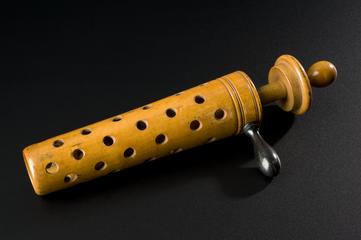Prototype magnetically manoeuvring wireless capsule endoscope
Modified PillCam 'ESO 2' oesophageal wireless capsule endoscope, with one of two cameras replaced with neodymium iron boron magnets enabling it to be manipulated remotely by a handheld external magnet, Given Imaging, Israel, 2007-2009. The capsule's original magnetic switch was swapped with a thermal one activated by being placed in hot water.
More
Capsule endoscopy is a procedure that uses a tiny wireless camera to take pictures of the digestive tract. It helps practitioners see inside the small intestine—an area that isn't easily reached with a traditional endoscopy which involves passing a tube through an opening such as your mouth.
The camera sits inside a vitamin pill-sized capsule that is swallowed by the patient. As the capsule travels through the digestive tract, the camera takes thousands of pictures that are transmitted to a recorder worn by the patient. Capsule endoscopy is most commonly used to locate the source of unexplained bleeding from the gut. The main drawback is lack of control of movement; the devices are propelled naturally by peristalsis (the muscle contractions that move food through the digestive tract) and gravity.
Gastroenterologist Professor C. Paul Swain, who co-developed and swallowed the first capsule endoscope (2022-1366), subsequently led research to create magnetic capsules that could be externally manipulated by a handheld magnet, enabling practitioners to pause, turn and direct the devices where necessary for closer inspection.
This prototype was one of a batch of six tested in anaesthetised pigs at the Royal Veterinary College, London. Pre-dating the first human study, they are perhaps the earliest surviving examples of such devices, which could one day make wireless delivery of targeted drug therapies and robotic biopsy a reality.
- Measurements:
-
overall: 25.3 mm 11.6 mm,
- Materials:
- silicon , metal (unknown) and neodymium iron boron
- Object Number:
- 2022-1367/5/1





